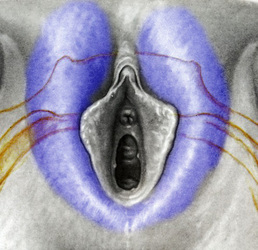Nature abhors a vacuum Preparing a chapter on Cosmetogynecology, I reviewed a mountain of material and reflected on the basic and complex issues that arise repeatedly. One of the very first, and very basic, things which came to mind was the blatant absence of a guide to the terminology of cosmetic gynecology. Even the topic goes by a half-dozen names, some of which you're seeing in these first few sentences. So, without further elaboration, I present you with the first description of the current lexicon of cosmetic vaginal surgery, aesthetic vaginal surgery, female genital cosmetic surgery, or cosmetic female genitoplasty: Preface: Learn a Little GreekThe terms aesthetic, cosmetic, and plastic are related, but they are not synonymous. Grasp this and your ability to articulate your message will improve instantly. Aesthetic derives from the Greek word aisthetikos which means to perceive and judge sensory input as beautiful. When used as an adjective (i.e. an aesthetic contour), it defines the subject as beautiful. When used to describe interventions that enhance beauty, the term is inherently flawed. For instance, the term aesthetic surgery, defines the subject, surgery, as that which is aesthetic, or beautiful. However, the intended meaning of the phrase is something else - that the intention of the surgery is to enhance the aesthetics of he/she who is being operated upon. Not only is this poor grammar, but it also renders any surgery which happens to beautiful to watch, in any field of surgery, as robbed of its proper adjective. Cosmetic derives from the Greek word kosmetikos, which means to adorn or to make beautiful (aesthetic). Here, we have a term that precisely defines the intent to beautify. Cosmetic surgery thus, properly and accurately identifies any surgical process which intends to enhance the aesthetics of the person being operated upon irrespective of whether the surgical process is itself aesthetic. In brief, a cosmetic process creates an aesthetic product, while an aesthetic process creates an undefined product. Plastic derives from the Greek word plastikos, which means to reshape. Plastic is a nonspecific concept that does not define the reason for the action. When applied in the term plastic surgery, further classification is required when specificity is desired (i.e. reconstructive plastic surgery). Adding complexity to the confusion are the observations that plastic surgery is the common name of a surgical specialty with both noncosmetic and cosmetic subdivisions (which some refer to as aesthetic plastic surgery), that many operations in many surgical specialties outside of plastic surgery reshape the body for various reasons, and that surgeons from many specialties provide cosmetic surgery. The Lexicon of Cosmetic Gynecology 2013:Clitoral hood reduction, excision of excess prepuce, or excision of periclitoral labial reduplication, are procedures which target redundant, loose skin at, and around the clitoral prepuce either alone or at the time of labiaplasty. These procedures lack a uniform descriptive term. "Hoodectomy" is a poor terms for these procedures because it implies that clitoral hood proper is being degloved either partially or in its entirety - maneuvers that are not done in the conduct of cosmetic gynecology.
Clitoroplasty refers to surgical alterations in the shape of the clitoris proper, either glans or shaft, done for conditions associated with clitoral hypertrophy rather than for the cosmetic enhancement of normal anatomy. Partial excision is termed clitoral reduction or partial clitoridectomy and is not done for cosmetic reasons. Dermalipectomy is a term frequently used in cosmetic and plastic surgery to describe the en bloc excision of skin and fat. It is usually performed in tandem with the development of a flap of adjacent tissue for the purpose of reducing tissue laxity. Common applications include abdominoplasty, thighpasty, and in cosmetic gynecology, mons pubis "lift" procedures and labia majora volume reductions. Designer laser vaginoplasty™(DLV™) is a term trademarked by Dr. David Matlock’s franchise business which references the entire category of labiaplasty procedures as well as alterations of the loose skin at and near the clitoral hood all performed with laser techniques. Confusion is generated by the inclusion of vaginoplasty in the term despite the fact that it does not reflect the performance of a vaginoplasty in the procedure. Genitoplasty refers to any procedure which reshapes the male or female genitalia. It does not imply cosmetic or therapeutic intentions. Thus, it must be further classified whenever it is used. The most common utilization is feminizing genitoplasty which describes procedures intended to give ambiguous genitalia a female appearance. Hymenoplasty describes procedures designed to create a pseudo hymenal membrane from either existing hymenal tissue or nonhymenal local soft tissue usually with the intent to provoke bleeding at subsequent coitus when the membrane is caused to tear. Synonyms include hymenorrhaphy, hymen reconstruction, and hymen restoration. Revirgination is a poor term because the loss of virginal status is a matter of history, not of anatomy. Labiaplasty or labioplasty, can refer to any procedure which alters the contours of either the labia majora or the labia minora whether it involves reduction, reconstruction or augmentation. Commonly it references labia minora reduction by excision which is the most requested labial alteration. Labial reduction is sometimes used synonymously with labia minora reduction. The most frequently performed labia majora alterations are augmentation by autogolous fat injections and excisional reduction. The more specific terms labia minoraplasty and labia majoraplasty are less frequently used. Laser vaginal rejuvenation™(LVR™) is a term trademarked by Dr. Matlock’s franchise to reflect vaginoplasty procedures performed with laser techniques. Others have taken to using the term vaginal rejuvenation to indicate vaginoplasty with or without the use of lasers. Monsplasty refers to any procedure which alters the contours of the mons pubis. These include liposuction procedures which reduce perceived excess adiposity as well as resections of skin and subcutaneous fat (dermalipectomy) performed alone or in conjunction with abdominoplasty. The use of any technology to assist in the liposuction process such as laser, ultrasound, etc., typically is indicated by use of the technology as a prefix (i.e. laser-assisted, ultrasound-assisted, etc.). Nymphectomy and nymphoplasty are terms synonymous with labia minoraplasty. They are less commonly used in contemporary English literature, but are sometimes used in French (nymphoplastie), and commonly in Spanish (ninfectomia, ninfoplastia), respectively. Vaginoplasty refers to any procedure targeted at reducing the vaginal caliber. These include approximations of the perineal body (perineorrhaphy or perineoplasty), and posterior colporrhaphies with or without plication of the levator muscles. In most cases, both procedures are performed together to produce a longer section of reduced vaginal caliber.
0 Comments
Your comment will be posted after it is approved.
Leave a Reply. |
AuthorMarco A. Pelosi, III, MD, is a cosmetic gynecologist, surgeon, lecturer & cofounder of the ISCG. You may contact him directly at [email protected] Archives
April 2020
Categories
All
|
We are ISCG |
Get to Know Us |
Stay Connected |






 RSS Feed
RSS Feed
